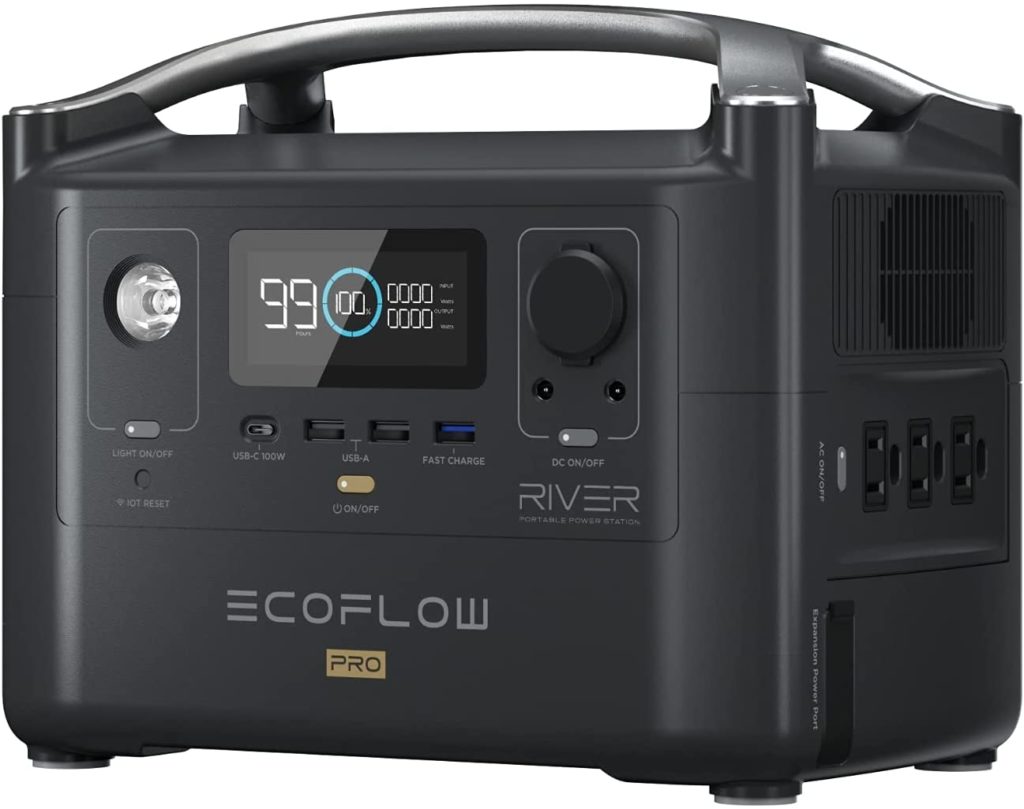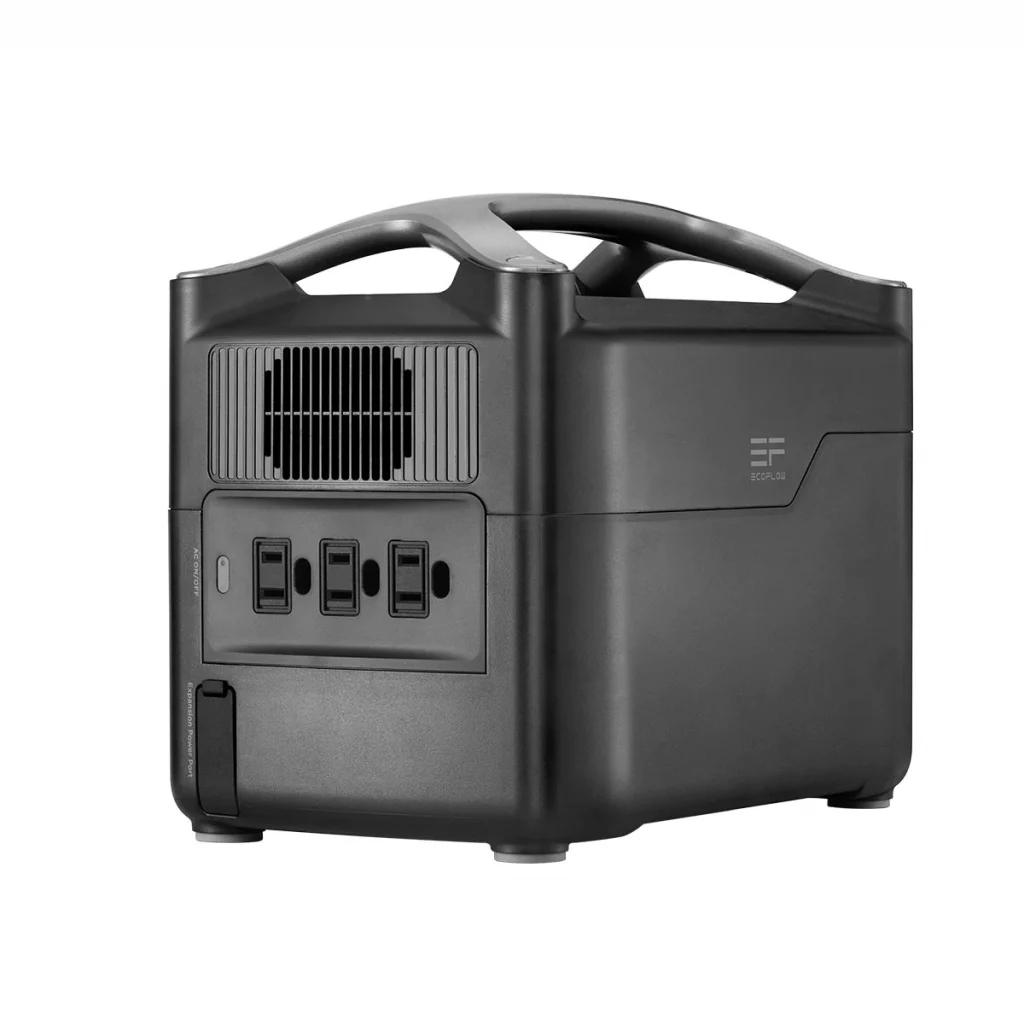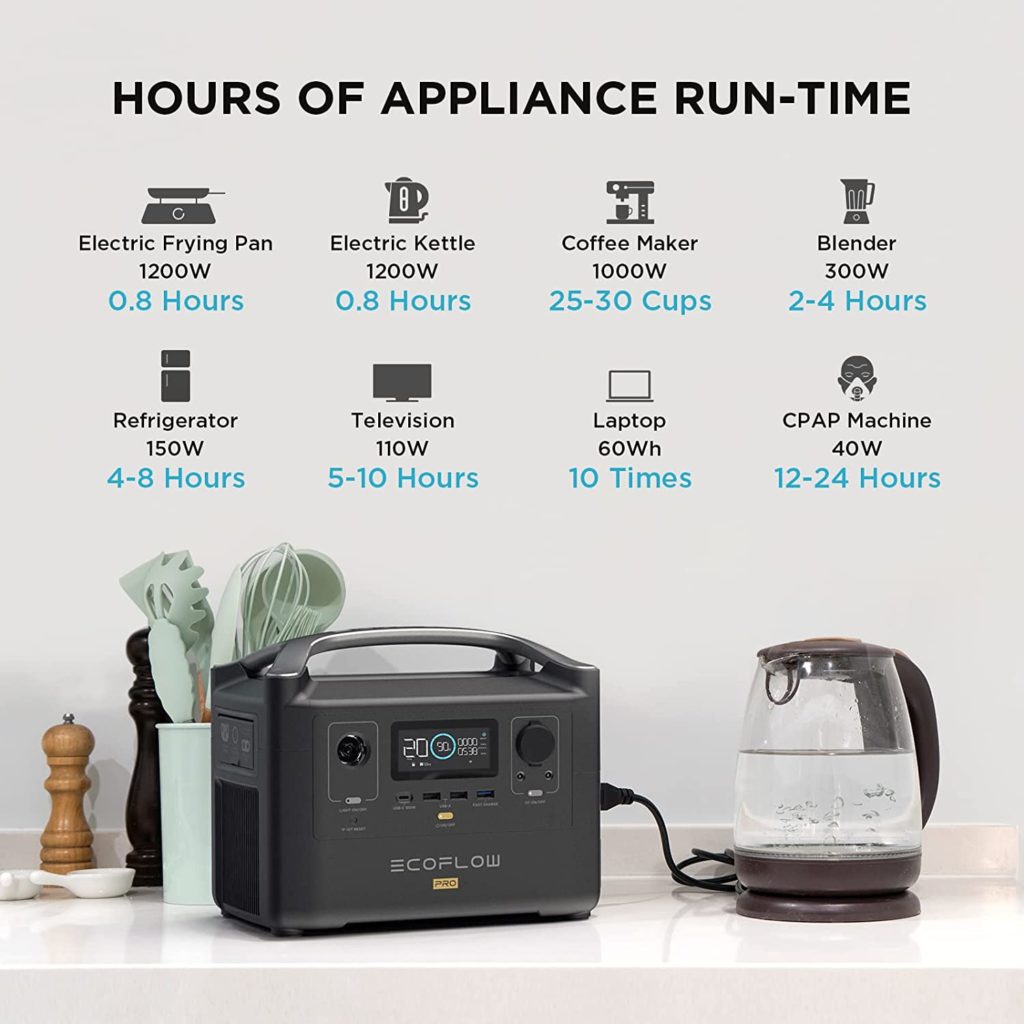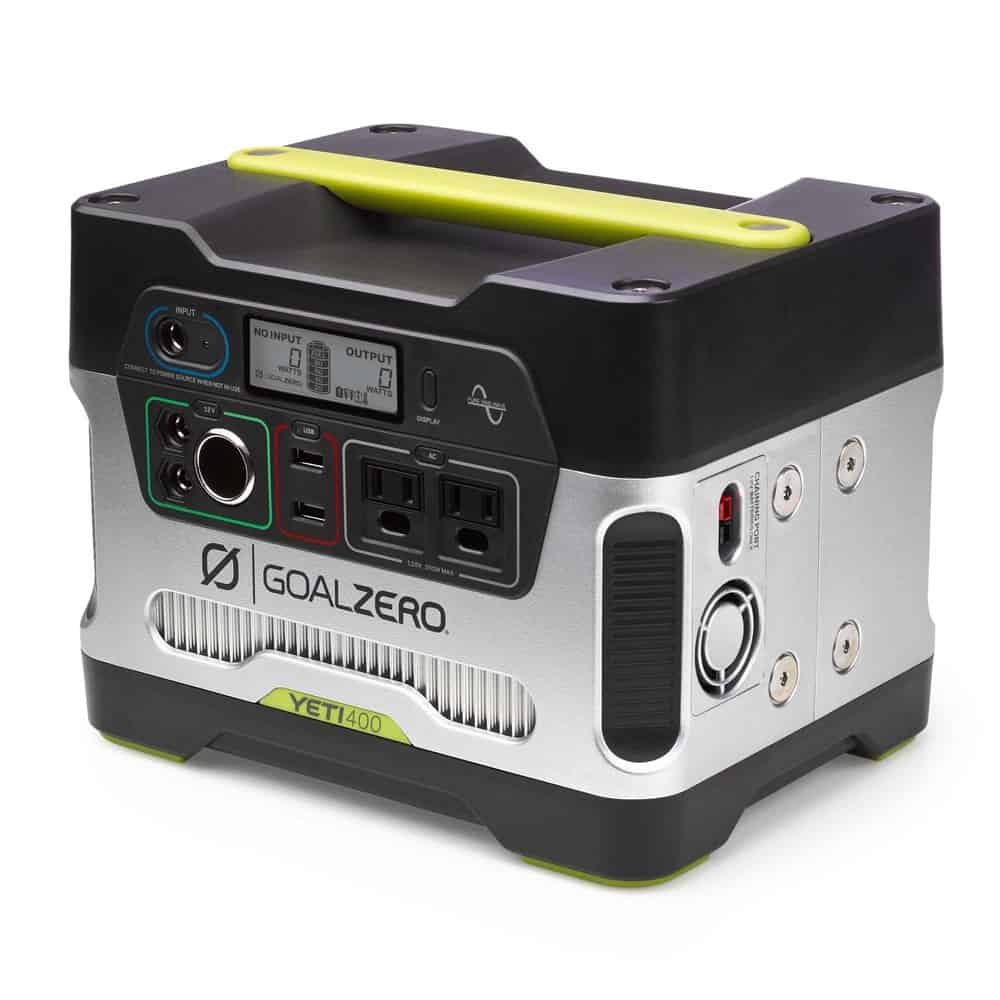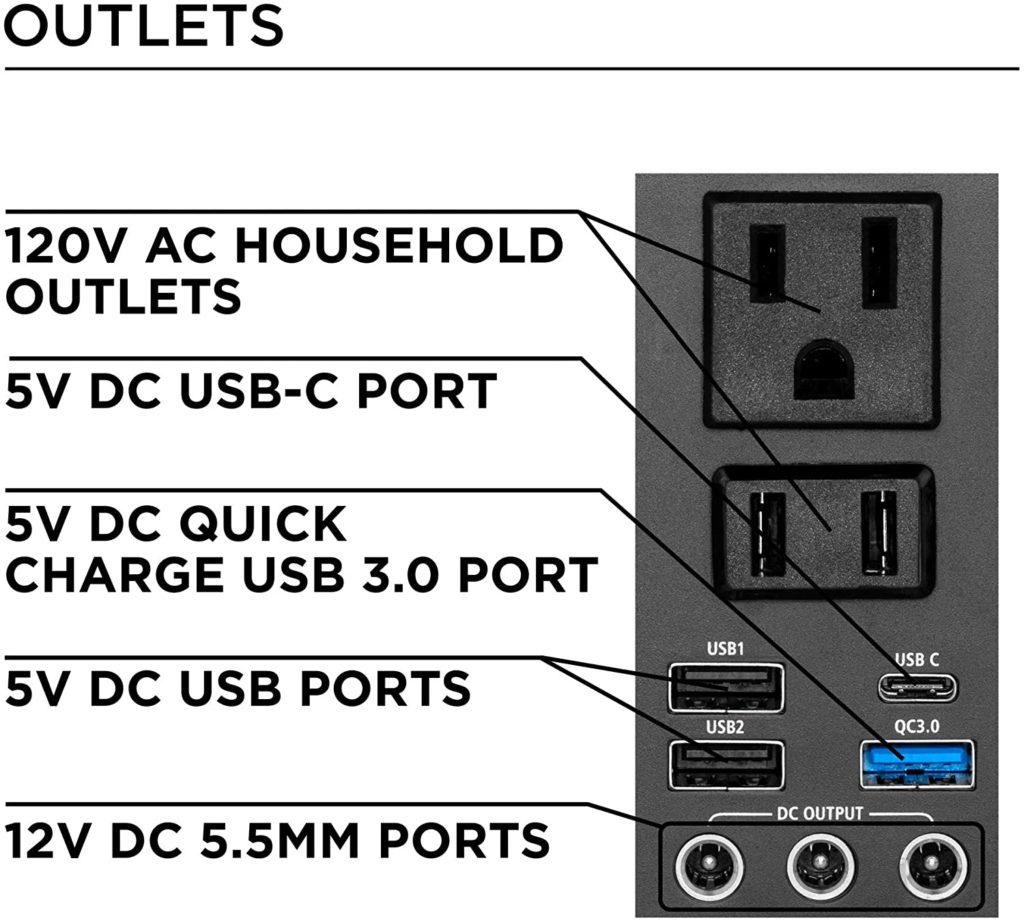If you want to prepare for blackouts, work on construction sites, and travel off-grid, consider getting a portable power station. The right pick can act as a power bank for multiple devices, including small fridges, laptops, drones, CPAP machines, and grills.
However, finding the right one is easier said than done. With so many brands and types on the market, choosing the best portable power station for you can be incredibly time-consuming and exhausting.
That’s why we’ve written this comprehensive guide to help you find your dream portable power station. Read on to learn more about what you should consider when looking for one and our review of the top portable power stations. We’ll also cover some frequently asked questions about portable power stations.
The 5 Top Portable Power Stations
Now that you know what to look for when buying portable power stations, let’s take a look at the five best power stations in 2022.
EcoFlow River Pro Portable Power Station
| Specification | Value |
|---|---|
| Dimensions | 11.4″ x 7.1″ x 9.3″ |
| Weight | 16.8 lbs. |
| Battery Capacity | 720Wh (28.8V) |
| Solar Panel Support | Yes |
| AC Power Outlets | 600W (Surge 1200W) total, 120Vac (50Hz/60Hz) |
| USB Ports | 5Vdc, 2.4A, 12W max per port |
| USB-C Ports | 5Vdc, 9Vdc, 12Vdc, 15Vdc, 20Vdc, 5A, 100W Max |
| Battery Life Cycle | 800 cycles to 80%+ capacity |
| Optimal Operating Temperature | 32 to 113°F +/- 5°F (0 to 45°C +/- 3°C)- Charge, -4 to 113°F +/- 5°F (-20 to 45°C +/- 3°C)- Discharge |
| Warranty | 2-years |
Our pick for best overall is the EF ECOFLOW Portable Power Station RIVER. Budget-friendly, powerful, and portable, this power station delivers 412 watt-hours or 114,000 milliamp-hours of power. At only 11 pounds, this product is incredibly portable, making it a great pick for home use and traveling. Use it on the go and to power your house or office during blackouts. You can also use it to power your CPAP devices while camping or RV’ing.
This model lets you power 11 devices at the same time with the following outlets:
- Two USB Quickcharge 2.0
- Two USB
- Two USB-C ports
- Two AC outlets
- Two DC outlets
- One 12-volt car port
Other standout features include:
- An advanced battery management system that holds a charge for up to a year
- Compatibility with ECOFLOW solar panels and generators
- An advanced thermal management system that delivers optimal performance in extreme conditions
- A user-friendly display that monitors performance
In short, the EF ECOFLOW Portable Power Station RIVER has everything you need to power appliances during blackouts, trips, and more.
Every purchase of this product comes with:
- An EF ECOFLOW Portable Power Station RIVER
- An AC wall charger
- A car charger
- A DC cable
- DC tips
- A USB Type-C cable
- A user guide
- A quick-start guide
Here’s what customers had to say about this product:
Pros
- EcoFlow app allows you to control the device from afar
- Supports 80% of essential devices in X-Boost mode
- Fast AC recharge
- Charge and discharge simultaneously
- Great for outdoor and home use
- Solar power supply
- Can power up to 10 devices simultaneously
Cons
- App doesn’t work that well
- Battery may die after a few hours
- DC port may break after days of continuous use
- Running too many power-hungry devices at the same time may break the device
- Pricey
Additional Resources
Goal Zero Yeti 1500X Portable Power Station
| Specification | Value |
|---|---|
| Dimensions | 15.25″ x 10.23″ x 10.37″ |
| Weight | 45.64 lbs. |
| Battery Capacity | 1516Wh (10.8V, 140.4Ah) |
| AC Power Outlets | 120VAC 60Hz, 16.5A (2000W, 3500W surge) |
| USB Ports | 5V, up to 2.4A (12W max) |
| USB-C Ports | 5 – 12V, up to 3.0A (18W max) |
| Battery Life Cycle | 500 Cycles to 80% capacity |
| Optimal Operating Temperature | 32-104 F (0-40 C) |
| Warranty | 2-years |
Our pick for the best solar power station is none other than the Yeti 1500X Portable Power Station Solar Generator. This model only requires four hours to fully recharge in the sun. In contrast, charging it from a 120-watt wall outlet or car charger takes 14 hours.
What’s more, it provides a whopping 1,500 watt-hours of lithium power, making it as powerful as many portable generators. As such, you can use this portable power station to:
- Run a full-size refrigerator for 28 hours
- Charge your phone 127 times
- Run a 60-watt pellet grill for 26 hours
- Run a 65-watt CPAP machine for 24 hours
- Run a 42-inch LED, 100-watt TV for 15 hours
- Power 11-watt lights for 138 hours
This beast has been field-tested in a wide variety of environments, from the home and job sites to the Arctic. It’s also incredibly safe, with the following types of protection:
- Temperature protection
- Over and under-voltage protection
- A battery management system to monitor cell and battery health
This model boasts the following output ports for running refrigerators, laptops, coffee makers, medical devices, power tools, phones, and other devices:
- Two USB-A
- An 18-watt USB-C
- A 60-watt USB-PD
- A 12-volt power port
- Two 120V AC inverters
Every purchase of this product comes with:
- A Yeti 1500X Portable Power Station Solar Generator
- 120W power supply (AC wall charger)
Pros
- Charges quickly with Goal Zero solar panels
- Compatible with the Yeti App 3.0
- Safe and user-friendly
- Durable battery
- Great for blackouts, traveling, and more
- Capable of running large appliances like fridges, chainsaws, and more
Cons
- Very pricey
- Heavy
- Poor customer service
- Unable to operate at lower voltages
- App doesn’t work very well

Goal Zero Yeti 1500X Portable Power Station
Additional Resources
Goal Zero Yeti 400W Portable Power Station
| Specification | Value |
|---|---|
| Dimensions | 10.25″ x 8″ x 8″ |
| Weight | 29 lbs. |
| Power Capacity | 400W |
| Battery Capacity | 396Wh |
| AC Power Outlets | 110V, 2.6A (300W continuous, 600W surge max) |
| USB Ports | 5V, up to 2.1A (10W max) |
| Battery Life Cycle | hundreds of cycles |
| Optimal Operating Temperature | 32-104F |
| Warranty | 12-months |
The best indoor power station on this list is the Goal Zero Yeti 400 Portable Power Station. A convenient power station with a 396 watt-hour capacity, this product can:
- Run small appliances for several hours
- Charge a phone over 30 times
- Charge a laptop over five times
Since this product doesn’t use gasoline and doesn’t emit toxic fumes, it’s completely safe to use in your car, home, or tent. It’s also silent, making it a great portable generator alternative for any event.
It also provides a versatile mix of powerful outputs, including:
- A USB port (output)
- A car port (output)
- An AC inverter (output, pure sine wave)
- A high-power charging port (input)
- A high-power chaining port
No matter where you are, you can keep this baby charged in three simple ways:
- In 13 hours using a car charger
- In five hours using a wall outlet
- In eight hours using Goal Zero’s monocrystalline solar panels
Every purchase of this product comes with:
- A Goal Zero Yeti 400 Portable Power Station
- A wall charger
Pros
- 2 AC outlets instead of one
- Compact small size
- Chainable batteries for longer power
- Last much longer after 500 cycles
- Equipped with user-replaceable battery
Cons
- No USB-C port
- Extremely heavy
Additional Resources
Westinghouse iGen160s Portable Power Station
| Specification | Value |
|---|---|
| Dimensions | 8.14″ x 3.77″ x 7″ |
| Weight | 3.75 lbs. |
| Battery Capacity | 42,000 mAh |
| AC Power Outlets | 120V 20A |
| USB Ports | 5V |
| Warranty | 2-years |
The best small power station is the Westinghouse iGen160s Portable Power Station. Weighing only 3.75 pounds, this lightweight power station is incredibly easy to carry around. Don’t underestimate its size, however — this power station supports charging all of your electronic devices and necessities, from speakers and GoPros to lights and drones.
This beast also has nine versatile outlets:
- Two 120-volt outlets
- Four USB ports including a QualComm Quick Charge 3.0 USB outlet and a USB-C
- Three DC outputs
Additional features include:
- Three-mode lighting: This portable power station comes with a built-in reading lamp and a dual-mode front flashlight for blackouts and overnight hikes.
- Four charging styles: This model boasts solar panel capability. It also comes with a cigarette lighter plug and AC outlet accessories for generators, cars, and walls.
- Built-in handle: The Westinghouse iGen160s Portable Power Station comes with a handle for maximum portability. Use this handle to carry the device or hook it onto your gear.
- Clear display: This product’s display shows AC/DC status and battery capacity. It also includes USB, DC, AC, and charging indicators.
Every purchase of this model includes:
- A Westinghouse iGen160s Portable Power Station
- A car charger
- A cigarette lighter plug
- A wall outlet charger
- A user manual
Pros
- Extremely portable and lightweight
- Safe for electronics
- Solar panel ready
- No fumes or noise
- Perfect for outdoor and indoor use
- No fuel or maintenance
Cons
- Choppy sine wave
- Short battery life
- Poor customer service
- Can only use one AC outlet at a time
- Not good at charging appliances
- Not a good choice for emergency situations

Westinghouse iGen160s Portable Power Station
Additional Resources
Jackery Explorer 1000 Portable Power Station
| Specification | Value |
|---|---|
| Dimensions | 13.1″ x 9.2″ x 11.1″ |
| Weight | 22.04 lbs. |
| Battery Capacity | 1002Wh (21.6V, 46.4Ah) |
| Solar Panel Support | Yes |
| AC Power Outlets | 110VAC, 60Hz, 1000W (2000W Surge) |
| USB Ports | 5V, 2.4A |
| USB-C Ports | 5V, 9V, 12V up to 3A |
| Battery Life Cycle | 500 cycles to 80%+ capacity |
| Optimal Operating Temperature | 14-104F (-10-40℃) |
| Warranty | 2-years |
The best portable power station for camping is the Jackery Portable Power Station Explorer 1000, 1002Wh Solar Generator. At 22 pounds, this model is one of the most lightweight heavy-duty power stations. Use it to power your computers, CPAP devices, grills, cameras, and other gadgets while off-grid.
With a staggering 1,002 watt-hours of capacity, it can supply over 1,000 watts of power or 2,000 watts of surge power through multiple output ports. As such, it meets the power supply needs of most high-power electrical appliances.
This product boasts the following output ports:
- Two USB-C
- One DC cart port
- Two USB
- Three pure sine wave AC outlets
Other standout features include:
- Efficient and eco-friendly solar charging when paired with SolarSaga 100-watt solar panels
- Durable exterior and interior
- Four ways to recharge: solar panel, electric generator, wall socket, and car output
Purchasing this model will give you:
- A Jackery Portable Power Station Explorer 1000, 1002Wh Solar Generator
- An AC adapter
- A car charger cable
- A SolarSaga parallel adapter cable
- A user manual
Pros
- Charges very quickly
- Perfect for traveling and blackouts
- Silent
- Durable interior and exterior
Cons
- Not the most reliable
- Customer service could be better
- Car charger takes too long
- USB ports may not work that well
Additional Resources
Choose the Best Portable Power Generator For You
Picking the best portable power generator can be a challenge. With so many competitive options on the market, it’s hard to know which is the best for you.
That’s why you should use our guide as a starting point. Take notes as you read through our section on the factors you should consider when looking for a portable power station. Then, look at our reviews and think about which portable power stations best fit your goals.
For instance, if you’re a camper who wants to power laptops and phones, consider getting the Jackery Portable Power Station Explorer 1000, 1002Wh Solar Generator. This lightweight yet heavy-duty portable power generator has everything you need for RV’ing, camping, and hiking excursions.
Or, if you’re an avid hiker living in a sunny area, consider getting a solar portable power station like the Yeti 1500X Portable Power Station Solar Generator. This powerful inverter generator draws power from the sun to provide 1,500 watt-hours of lithium power. Because it’s as powerful as many portable generators, you can use it to run full-size refrigerators, charge pellet grills, run TVs, and power CPAP machines for hours at a time. You can even use it to power lights.
After you’ve made a list of the goals you want to achieve with your portable power generator, make a list of required and “nice-to-have” features.
Here’s an example:
| Required Features | Nice-to-have Features |
| Lightweight | App connectivity |
| At least seven outlets | Solar panel ready |
| Safe for electronics | |
| Capable of powering appliances like mini-fridges |
After creating the list, look at your budget. If you have a limited budget, buy a portable power station that has all of your required features. But if you have the budget for it and you want all or some of the “nice-to-have” features, buy a portable power station that checks off most or all of the features on your list.
What You Should Consider When Looking for a Portable Power Station
Before we dive into our reviews of the top five portable power stations, let’s take a look at the factors you should consider when buying one. Carefully evaluate these factors before you buy a model — doing so will save you a lot of money, time, and energy.
Total Power Output and Battery Capacity
First, you need to look at your power station’s total power output and battery capacity. These ratings show you how many and what types of devices your station can power.
It can be difficult to understand the different power ratings for portable power stations. Depending on the vendor, some devices may use watt-hours, while others use watts. So here’s a breakdown of the most common ratings and what they mean:
- Watts (W): This unit shows the actual power rating of the station — in other words, the station’s maximum output.
- Watt-hours (Wh): Watt-hours measure how the battery capacity of your power station, or how long it’ll last. To determine the ideal watt-hour rating, think about the devices you want to power and how much energy they require. If you want to power multiple devices, look for higher watt-hour ratings, like 25 kilowatt-hours (kWh). However, these stations tend to be quite heavy and may be difficult to carry around, especially if you’re living or traveling alone.
- Milliamp-hour (mAh): As with watt-hours, the higher the milliamp-hour rating, the more devices you can power. However, this is a less accurate measure of the battery capacity compared to the watt-hour.
Number of Outlets or USB Ports
Besides power output and battery capacity, you also need to consider the number of outlets or USB ports. If you’re going to be charging multiple devices at once, get a station that has more than enough outlets and ports. This way, you can continue using your station as your device collection expands.
Hours of Power Provided
Next, you need to look at how many hours of power the power station provides. Make sure it provides more than enough hours for your trips. If you’re buying a portable power station for blackouts, make sure the device provides at least three to nine hours of power. For longer blackouts, you may have to buy a larger generator.
Price of the Model and Budget
You need to consider the price of the model and your budget. Look at your budget and make a list of the features on this list that you require versus ones that would be nice to have.” If your budget is limited, just get a budget-friendly portable power station with all of your required features. But if you have a larger budget, you could consider buying a more expensive model that has some or all of your “nice-to-have” features.
Charging Time
Another factor to consider is charging time. The longer your device needs to charge, the longer you’ll have to wait to use it. Unfortunately, most portable power stations take six or seven hours to charge. However, there are some models that only take four to five hours to charge.
Portable Design and Size
You should also consider the design, size, and weight of the product. Is it portable? If you need a small team of people to lift and move around your power station, it may not be the best choice, especially if you’re planning to use it for RV’ing, camping, and other highly-mobile situations.
Display Screen
Finally, you need to evaluate the display screen of the portable power station. Is it easy to read? Does it show the information it should show? If the user interface is confusing and hard to read, consider getting a model with a clearer display. A clear interface should make it as easy as possible for you to understand:
- How much power is left
- The power input
- The power output
FAQs
Portable power stations can power a wide range of devices, including laptops, phones, and mini-fridges. Basically, they can power any electric device that fits their power output and battery capacity.
Yes, a portable power station is worth the price. Most models are relatively budget-friendly and give you plenty of outlets to charge your devices.
There are two ways to use a portable power station:
Full-time use
If you’re using your machine full-time, plug it into a regular wall outlet. Then, plug the appliance(s) into the station. Because the power station stores electricity, the appliances will continue running even if the power goes out.
Full-time mode works well for powering critical medical devices like oxygen generators and CPAP machines. It’s also useful for powering laptops and other electronics on the go.
Outage-only use
If you’re only using your power station for outages, you should still plug it into a wall outlet at all times. When the outage occurs, you can unplug the device from the wall, move it to your appliances, and then plug them into the station.
This mode is a good choice when you want to provide power to convenience appliances like electric kettles, microwaves, and mini-fridges.
The best charging time for a portable power station is every hour of the day. Most portable power stations require four to six hours to fully charge. As such, you should keep them plugged in at all times to maximize their usefulness when you need them.
Yes, you can use a portable power station as a backup power source. Leading models store enough power to run a wider range of devices, but they’re generally not as powerful as portable generators. Portable generators are powered by fuel and can provide enough power output to light your RV, home, and appliances like fridges, freezers, and stoves.
However, there are some exceptions. For instance, the Yeti 1500X Portable Power Station Solar Generator can power anything you want from a wall outlet, including kitchen appliances, lights, fridges, and more. It has enough power to charge your phone 127 times and run a full-size refrigerator for 28 hours.
Depending on the model, a portable power station can be recharged in various ways, including via:
•Solar panels
•Car outlets
•Wall outlets
•A mix of the above


